The Saas Valley and its Development
How the glacial valley became habitable
Saas was once part of a glacial valley whose icy expanses reached through the canton of Vaud as far as the Jura.
Through the ages, the freezing, overcast climate gave way to sunshine and the warmth of the sun melted the glaciers.
The natural world quickly re conquered the newly exposed slopes and plains, offering protection from the cold winds,
while rain and dew made the earth fertile.
The glaciers, though still growing at certain periods, retreated to the highest snowy uplands.
From this time on, the Saas valley was covered in dense woodland.
The first inhabitants of the Valais
The first inhabitants of the Valais region were migrating Celts.
They were conquered by the Romans just before the birth of Christ.
The Roman emperor made the Valais part of Italy and trading began over the Alps.
Is it possible that the Monte Moro pass was used as a trading route even then?
Coins found at the top of the Antrona Pass in 1963 by the Saas Fee mountain guide Albert Imseng would seem to suggest it was.
The Romans were followed by the Franks and invaders from Burgundy.
Did the Saracens leave the people of the Saas any more than the shape of their nose
In 939 the Saracens, also known as the Moors, invaded the Valais.
The King of Arles tolerated these fierce,
warlike people on condition that they defended the mountain passes against his enemies.
Their headquarters was in Almagel (today called Almagell).
As well as the typically shaped nose, which they are supposed to have left the Saas people,
it is assumed that some of the place names, passes and mountains also date from those days.
Hence Monte Moro, which means Moors Mountain, and Arabic sounding names such as Almagell,
Allalin and Mischabel could come from the Saracens.
As these names are still used today, it is assumed that the original inhabitants of the Saas valley,
who were probably shepherds and farmers, were in close contact with the Saracens.
From agriculture and trade to tourism in the Saas valley
Towards the end of the 18th and the beginning of the 19th century,
people who were attracted by this landscape came to the Saas valley;
travel writers, cartographers, mineralogists, botanists and landscape artists.
With their writings and paintings they spread the valley's fame far and wide.
It was not long before the first tourists appeared, fascinated by the magic of the mountain world.
In Saas Grund they stayed in the "Gasthaus zur Sonne" (1833), and later in the "Pension Monte Rosa" (1850) and the Hotel "Monte Moro" (1856),
built on the advice of the priest Johann Josef Imseng, the great pioneer of tourism in the Saas valley,
who hirnself had a hotel built in Mattmark in 1856.
Still no hint in Saas Fee of the tourist developments in the valley.
Even though there had been countless first ascents in the Alps,
and by 1880 all the four thousand metre peaks in the Saas valley, with the exception of the Stecknadelhorn,
had been climbed, even by the clergyman in his cassock, in the village of Saas Fee there was still no hint of the tourist development in the valley.
What were the reasons for this restraint? The village lay away from the centre of the valley.
The inhabitants eked out a meagre existence mainly from farming and tending their alpine pastureland.
Time moved more slowly there. The people lived close to nature and its secrets, which they could barely fathom.
They were in constant fear and dread of the mountains, avalanches and torrents.
They were amazed when tourists spoke of the beauty of nature and the artists immortalised the "terrible" mountains and threatening glaciers in paint.
Now they had to try to accept the strange people who wore different clothes and spoke in a language they did not understand.
Above all they had to try to understand the romantic ideology of the tourists,
put aside their dread of nature and discover for themselves the beauty of the mountains and the glaciers.
That took the village some time.
The glacier village becomes a spa resort
Saas Fee was late to embrace tourism.
The outward appearance of this village of mountain farmers changed quite suddenly.
The first hotel was built by the Saas Fee authorities in 1880/81 and was given the name Dom,
after the mountain which, at 4545 metres above sea level, is the highest peak entirely within Switzerland's borders.
This was a historic decision for Saas-Fee, because this hotel marked the beginning of the age of tourism for the glacier village.
Within twelve years three more hotels followed; in 1883 the Hotel Bellevue, on the site of the Walliserhof today;
in 1893 the Grand Hotel; and in the same year the Hotel Beau Site.
These four hotels gave the village its defining features and a new world was born within this enclosed community.
The first hotel guests, during the Belle Epoque, were from the aristocracy, nobility, wealthy romantics and eccentric Englishmen.
A priest as pioneer of tourism
The priest Johann Josef Imseng did not live to see the historic growth in the village where he was born (1806 1869),
but he has gone down in the history of tourism in the valley thanks to his pioneering spirit.
As an hotelier he paved the way for tourism in the valley.
As a mountain guide he brought tourists to the valley and took them up the mountains.
He was the first person to use skis in Switzerland; in 1849 skiing with home made wooden runners from SaasFee to Saas Grund.
In gratitude to him, subsequent generations erected a statue of him in the square in Saas Fee.
He stands there steadfastly on the Hauptstrasse, while the ever changing colours of the cosmopolitan world pass him by.
The road
In May 1949 approval was granted in Bern for the building of a road from Saas Grund to Saas Fee.
Work began in spring 1950.
The road wound up to the village in two snaking hairpin bends, but did not enter it.
There was never such unity of purpose between the authorities and the population
as in the decision to end the road directly behind the picturesque "Stadel" barns on the ridge of cliffs
which stand like guards in front of the village; ensuring that Saas Fee preserves its unique identity.
The first car drove to Saas Fee on 8 July 1951 (President Hubert Bumann, 1949 - 1969).
It was a big day for the village; a historic event.
Tourist development was now unstoppable.
"The Pearl of the Alps" begins where the road stops
***



























